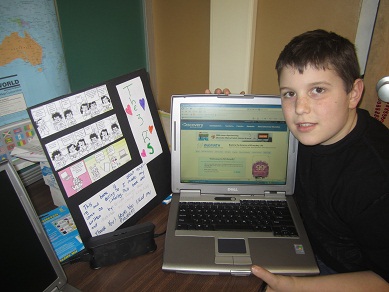
With an overwhelming 25,000 educators participating in Digital Learning Day on Feb. 6, ed-tech supporters used technology-based projects, lessons, and enthusiasm to mark what they called a perfect time to launch a national digital learning campaign.
“Every day should be Digital Learning Day,” said Karen Cator, director of the U.S. Department of Education’s Office of Educational Technology. “Access to technology has become as important to learning as access to a library, yet teachers remain the critical link between students and the content.”
Cator said teachers are setting expectations for multiple “revision cycles” of student productions, made possible with “professional tools for writing, composing music, creating video documentaries, and design.”
“They are learning along with their students and modeling good questioning and internet research strategies, assigning more complex and challenging projects, and facilitating communication and collaboration even across borders,” she said.
(Next page: Free ed-tech resources and initiatives)
“The president and I are convinced that with technology, we have an extraordinary opportunity to expand educational excellence and equity, and personalize the experience for students,” said Education Secretary Arne Duncan, who attended Digital Learning Day in Washington, D.C.

Along with teachers, students, and parents representing all 50 states, Digital Learning Day garnered support from nearly 50 national partners and 25 corporate partners.
Efforts included:
• Facebook worked with a range of stakeholders to develop resources and tools to help educators understand how to use social media inside and outside of the classroom.
• KnowledgeWorks’ World of Learning blog featured essays about the benefits and opportunities of digital and blended learning. Throughout the year, Principal Erin Frew of Cleveland’s West New Tech High School (who also works for KnowledgeWork’s New Tech Network) will be an expert resource for Digital Learning Day’s toolkit to help teachers in specific subject areas.
• The National Council of Teachers of English released a Framework for 21st-Century Curriculum and Assessment that recognizes that to be 21st-century literate, students must become proficient with the technology tools and use them to create and manage information, build meaningful relationships with others so they can inquire and work together, reflect on their own work processes and products, critically evaluate the multimedia sources and tools they use, and use these sources and tools ethically.
• American Graduate: Let’s Make It Happen, a multi-year initiative of the Corporation for Public Broadcasting, featured its Classroom Resources on the Digital Learning Day website. Classroom Resources connects teachers, parents, and students with easy navigation to the best of public media’s educational resources targeted to middle and high school youth.
• The National School Boards Association will be hosting its annual series of Technology Site Visits this spring to provide school leaders and educators with an in-depth look at the policies and practices that support digital learning.
• Global Kids, an in-school and after-school New York City youth program, had high school students learn about game design skills and global issues using the online platform Gamestar Mechanic. These students became expert mentors and will lead workshops across the city and enroll youth in the National STEM Video Game Design Challenge.

• The Alliance for Excellent Education (AEE), which hosts Digital Learning Day, is offering Digital Learning: Lessons in Action, which incorporates multiple strategies with digital learning, such as collaboration, personalized learning, project-based learning, flipped classrooms, virtual access to experts, and simulations.
(Next page: A groundbreaking initiative called Project 24; an ed-tech MOOC for educators; and Instagram)
Perhaps most noteworthy, AEE has more than 250 school districts, representing approximately 2.5 million students across 42 states, participating in its groundbreaking new initiative, called Project 24, which will help school districts plan for, and effectively use, technology and digital learning.
The “24” in Project 24 represents the next 24 months, a time during which the nation’s education landscape will change greatly as states and districts face numerous challenges—including the need to implement college- and career-ready standards for all students; use online assessments to gauge comprehension and learning; push for greater system and classroom innovation; deal with shrinking budgets; and contend with demands of states’ waivers from key provisions of the No Child Left Behind Act.
To participate, a school district must (1) sign up at www.all4ed.org/project24; (2) assemble a team composed of the district superintendent or a representative, a district curriculum leader, the district technology director, and a district professional development leader; and (3) take the free self-assessment. Upon completion of the self-assessment, a confidential, customized report will be generated for each district.
“With Project 24’s self-assessment tool, district leaders can frame their vision for student learning, begin to recognize the various aspects of the system that need to be addressed, and specify how technology can help align these efforts to achieve higher college- and career-ready standards,” said Bob Wise, AEE president and former governor of West Virginia. “It will help district leaders move beyond counting computers and internet connections to analyzing how they can integrate technology into their instructional plans.”
Partnering with other national membership organizations, the Alliance has identified a framework with seven major components that will provide education leaders in states and school districts with tools to make good decisions about how technology aligns with the goals and visions for their students. The framework will provide assistance to districts on (1) academic supports, (2) budget and resources, (3) curriculum and instruction, (4) data and assessments, (5) professional learning, (6) technology and infrastructure, and (7) use of time.
In conjunction with the Friday Institute for Educational Innovation at North Carolina State University, AEE has developed a Massive Online Open Course for Educators (MOOC-E), called “The Digital Learning Transition in K–12 Schools: A Planning MOOC for Educators.” The six-week course is designed to provide a new type of learning experience for education leaders, one that will help them identify the potential of technology-enabled learning opportunities for the district, including its leaders, teachers, and students. The course will kick off on April 8.
More information on Project 24 is available at www.all4ed.org/project24.
Want to get even more involved? Throughout the rest of February, educators are encouraged to capture digital learning in action. Enhance and share your photo using the Instagram photo app, and tag it using #DLDay and @digitallearningday. Remember to review Instagram’s policies, and be sure that any students included in your photo have necessary waivers. Digital Learning Day will post the best photos on its website, and there might even be prizes for the best photos at the end of the month. Learn more here.
Follow Associate Editor Meris Stansbury on Twitter at @eSN_Meris.
- #4: 25 education trends for 2018 - December 26, 2018
- Video of the Week: Dealing with digital distraction in the classroom - February 23, 2018
- Secrets from the library lines: 5 ways schools can boost digital engagement - January 2, 2018

